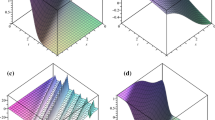Abstract
This work contains a transformation of Hill-Brown differential equations for the coordinates of the satellite to a type which can be integrated in a literal form using an analytical programming language. The differential equation for the parallax of the satellite is also established. Its use facilitates the computation of Hill's periodic intermediary orbit of the satellite and provides a good check for the expansion of the coordinates and frequencies. The knowledge of the expansion of the parallax facilitates the formation of differential equations for terms with a given characteristic. These differential equations are put into a form which favors the solution by means of iteration on the computer. As in the classical theory we obtain the expansions of the coordinates and of the parallax in the form of trigonometric series in four arguments and in powers of the constants of integration. We expand the differential operators into series in squares of the constants of integration. Only the terms of order zero in these expansions are employed in the integration of the differential equations. The remaining terms are responsible for producing the cross-effects between the perturbations of different order. By applying the averaging operator to the right sides of the differential equations we deduce the expansion of the frequencies in powers of squares of the constants of integration.
Similar content being viewed by others
Abbreviations
- f :
-
the gravitational constant
- E :
-
the mass of the planet
- M :
-
the mass of the satellite
- t :
-
dynamical time
- x, y, z :
-
planetocentric coordinates of the satellite
- u :
-
x+y√−1
- s :
-
x−y√−1
- ϱ:
-
the planetocentric distance of the satellite
- w :
-
1/ϱ
- ϱ0 :
-
the variational part of ϱ
- w 0 :
-
the variational part ofw,
- n :
-
the mean daily sidereal motion of the satellite
- a :
-
the mean semi-major axis of the satellite defined by means of the Kepler relation:a 3 n 2=f(E+M)
- a :
-
the mean semi-major axis defined as the constant factor attached to the variational solution
- e :
-
the constant of the eccentricity of the satellite
- ψ:
-
the sine of one half the orbital inclination of the satellite relative to the orbit of the sun
- c(n−n′) :
-
the anomalistic frequency of the satellite
- c 0 :
-
the part ofc independent frome,e′, γ and α
- g(n−n′) :
-
the draconitic frequency of the satellite,
- g 0 :
-
the part ofg independent frome,e′, γ and α
- ζ:
-
exp (n−n′)t√−1
- D :
-
ζd/dζ
- e′:
-
the eccentricity of the solar planetocentric orbit
- a′:
-
the semi-major axis of the solar orbit
- n′:
-
the mean daily motion of the sun in its orbit around the planet
- m :
-
n′/(n−n′)
- α:
-
a/a′-the parallactic factor
- Ω:
-
the disturbing function
References
Adams, J. C.: 1877, ‘On the Motion of the Moon's Node’,Monthly Notices Roy. Astron. Soc. 38, 43.
Andoyer, H.: 1926,Cours de mécanique celeste, Vol. 2, pp. 134–242,
Barton, D.: 1966, ‘Lunar Disturbing Function’,Astron. J. 71, 438–39.
Broucke, R.: 1968,Computerized Series Expansions: Applications to Lunar Theory, Vol. III. JPL Space Programs Summary 37–55, pp. 9–12.
Broucke, R. and Garthwaite, K.: 1969, ‘A Programming System for Analytical Series Expansion on a Computer’,Celes. Mech. 1, 271–84.
Brown, E. W.: 1896–1899, ‘Theory of the Moon’,Mem. Roy. Astron. Soc. 53, 39–116, 163–202.
Charpont, J. and Mangeney, L.: 1969, ‘Développements littéraux dans la théorie analytique de la Lune’,Astron. Astrophys. 2, 425–45.
Danby, J. M. A., Deprit, A., and Rom, A. R. M.: 1965,The Symbolic Manipulation of Poisson Series, BSRL Note 432, Boeing Scientific Research Laboratories.
Deprit, A.: 1969, ‘Canonical Transformations Depending on a Small Parameter’,Celes. Mech. 1, 12–30.
Deprit, A. and Henrard, J.: 1970, ‘Analytical Lunar Ephemeris: Delaunay's, Theory Revisited”,Science 168, 1569–70.
Elmabsout, B.: 1970, ‘Méthode semi-numérique de résolution du problem de Hill-Application à Phoebe’,Astron. Astrophys. 5, 68–83.
Faa-de-Bruno: 1855, ‘Note sur une nouvelle formule de calcul differential’,Quart. J. Math. 1, 359.
Hill, G. W.: 1878, ‘Researches in the Lunar Theory’,Am. J. Math. 1, 5–26, 129–47, 245–60.
Hill, G. W.: 1886, ‘On the Part of the Motion of the Lunar Perigee which is a Function of the Motion of the Sun and the Moon,Acta Math. 8, 1–36.
Kamel, A. A.: 1969, ‘Expansion Formulae in Canonical Transformations Depending on a Small Parameter’,Celes. Mech. 1, 190–99.
Tokmalaieva, S. S.: 1956,Analytical Theory of Motion of the Seventh Satellite Jupiter (russ.). Trudy I.T.A. Leningrad.
Author information
Authors and Affiliations
Rights and permissions
About this article
Cite this article
Musen, P. On a transformation of the differential equations of the lunar theory. Celestial Mechanics 3, 289–311 (1971). https://doi.org/10.1007/BF01231802
Received:
Issue Date:
DOI: https://doi.org/10.1007/BF01231802




